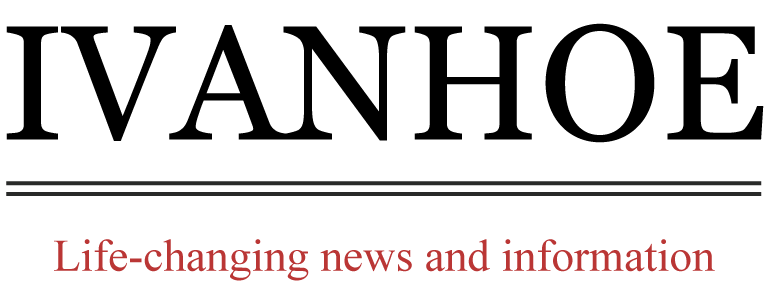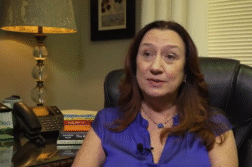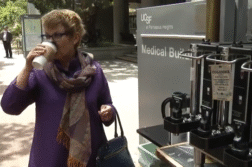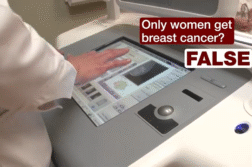BALTIMORE, Md. (Ivanhoe Newswire) — For many breast cancer patients who undergo mastectomy or lumpectomy, pain persists for weeks after the surgery. But for between twenty and thirty percent of those patients, the pain never goes away. However more and more doctors are finding ways to bring relief.
In October 2009, Lauren Gilbert was diagnosed with stage one breast cancer. A lumpectomy spared her breast and saved her life, but started a cycle of pain she was not prepared for.
“I called them zingers, where all of a sudden an electrical shock goes right though my breast from my back.” Gilbert described to Ivanhoe.
It’s called PMPS or post mastectomy pain syndrome.
“Some patients will describe a shooting burning pain. Sometimes across the chest wall, other times in the axilla of the arm pit. It can even come down the arm a bit.” David Maine, MD, an Anesthesiologist/Pain Management Specialist at Mercy Medical Center in Baltimore, Maryland explained.
Dr. David Maine is a pain management specialist in Baltimore. He says injuries to the nerve branches in the chest wall create chronic pain, tearing away at quality of life.
Gilbert continued, “I wasn’t suicidal at that point, but I didn’t know how much longer I wanted to live with that much pain all day, every day.”
“Her personality changed. That was hard to deal with.” Laurens husband Mike said.
Using imaging guidance, Dr. Maines’ placed a needle into the rib area on top of the nerve root, applying a corticosteroid or nerve block, bringing Lauren’s pain down from a nine or ten.
“After the procedure I had two weeks ago, I’m at a one or two most days.” Lauren said.
“I got my wife back.” Mike stated.
Doctors say the procedure can be repeated, as needed to control pain. In addition to this therapy, doctors can also prescribe medication commonly used for epilepsy that is also used to treat neuropathic pain.
Contributors to this news report include: Cyndy McGrath, Field Producer; Roque Correa, Editor.
POST MASTECTOMY PAIN SYNDROME
REPORT #2388
BACKGROUND: PMPS, also known as post mastectomy pain syndrome, is a side-effect 20 to 30% of women experience after going through a mastectomy or lumpectomy. The common symptoms of this syndrome consist of pain in the chest wall, armpit, and/or arm that does not go away over time. Although the pain can range from mild to severe, 10% of patients inform that the pain is so excruciating, it affects their quality of life. The syndrome was first described in the late 1970s. The condition starts with tissue damage
(Sources: http://www.cancer.org/treatment/treatmentsandsideeffects/physicalsideeffects/pain/post-mastectomy-pain-syndrome & http://www.clinicalpainadvisor.com/chronic-pain/postmastectomy-pain-syndrome/article/495251/)
RISK FACTORS: A recent study has researched what the risk factors are for developing PMPS. The study found that the use of halogenated anesthesia, perioperative pain, and the use of adjuvant therapy are risk factors to developing the syndrome. Other risk factors include young age, radiation therapy, chemotherapy, large tumor size, higher body mass index, and more invasive mastectomy procedures. The major factor is breast surgery, but PMPS can occur with or without axillary surgery.
(Source: http://www.clinicalpainadvisor.com/chronic-pain/postmastectomy-pain-syndrome/article/495251/2/)
MEDICATION & OTHER TREATMENTS: PMPS can be treated with medication. Doctors normally prescribe medicine to help with the pain of this syndrome but they stay away from opioids. Since PMPS is a nerve-related pain, nerve pain medications, like membrane stabilizers, are the ones usually prescribed. Another option to treat PMPS is to block the pain directly. X-rays and ultrasounds can be used to identify which nerves are causing the pain in order for them to be blocked. The nerve is blocked by placing a needle into the rib area on top of the nerve root. Corticosteroid or a nerve block is applied bringing down the severity of the pain immediately. This procedure can be repeated as many times as needed. Furthermore, steroids can help with the pain and in some cases the entire nerve can be removed. The treatment will depend on the patient and the severity of their pain.
(Sources: http://www.cancer.org/treatment/treatmentsandsideeffects/physicalsideeffects/pain/post-mastectomy-pain-syndrome & http://www.baltimoresun.com/health/breastcancer/bs-hs-mastectomy-pain-20161006-story.html & Dr. David Maine)
* For More Information, Contact:
Carroll Chase
Mercy Medical Center, Baltimore
410-332-9036
Free weekly e-mail on Medical Breakthroughs from Ivanhoe. To sign up: http://www.ivanhoe.com/ftk



